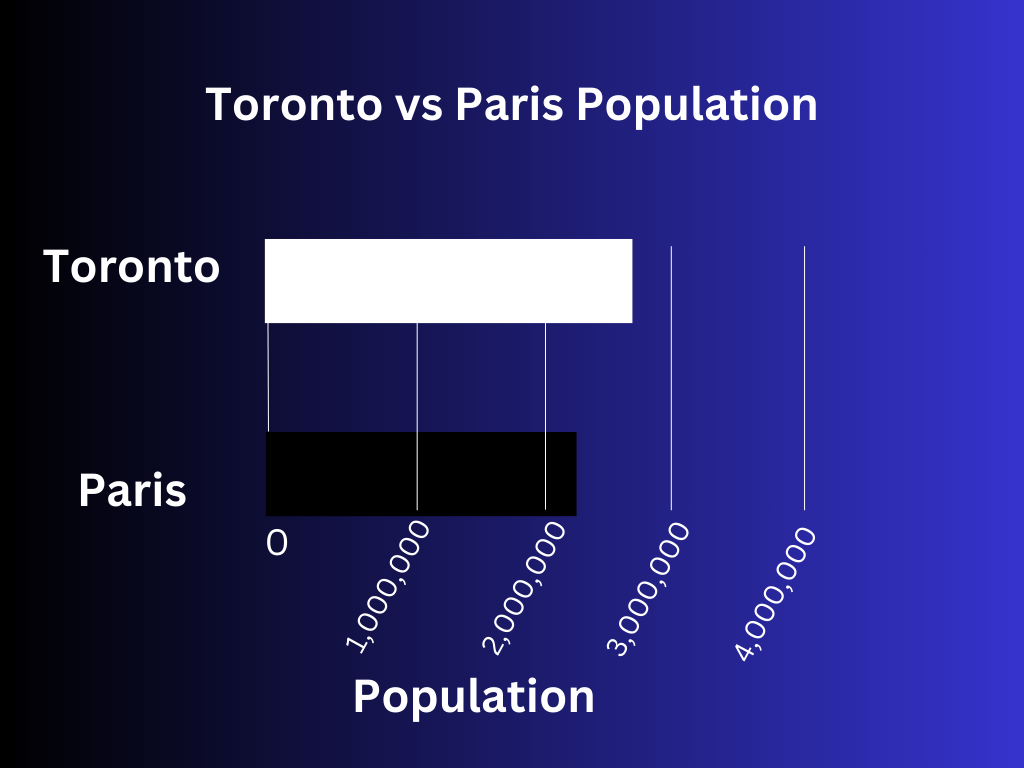
When it comes to iconic and vibrant cities, Toronto and Paris have etched their names in history. Both known for their unique charm, cultural diversity, and rich history, these cities attract millions of visitors each year. In this blog post, we will delve into a detailed comparison of Toronto and Paris, focusing on their population, size, and population density, revealing how these factors shape the experiences of residents and visitors alike.
Population

Toronto, with a population of 2,794,356, stands as Canada’s largest city and is a melting pot of cultures. The dynamic metropolis boasts a vibrant arts scene, a strong economy, and a reputation for being one of the most livable cities globally. On the other hand, Paris, with a population of 2,102,650, is the capital of France and a hub of fashion, art, and gastronomy. Known as the “City of Love,” Paris captivates visitors with its historical landmarks and romantic ambiance.
Size

When it comes to the geographical extent of these two cities, Toronto covers a vast area of 155,725.81 acres. This expanse provides ample room for a mix of skyscrapers, green spaces, and suburban neighborhoods. In contrast, Paris is relatively compact, occupying 26,044.907 acres. The city’s layout is a testament to its centuries-old history, with narrow streets leading to famous landmarks like the Eiffel Tower and the Louvre.
Population Density
| State | Area (acres) | Population | Population Density (KM2) |
| Toronto | 155,725.81 | 2,794,356 | 4,427.8 |
| Paris | 26,044.907 | 2,102,650 | 20,000 |
The population density of a city offers insights into the level of urbanization and how inhabitants share the available space. Toronto’s population density stands at 4,427.8/km², reflecting its status as a sprawling city. Despite being the largest city in Canada, Toronto’s population density is relatively moderate, allowing for more breathing room. Paris, as one of Europe’s most densely populated cities, boasts a population density of 20,000/km². The tightly packed streets and iconic apartment buildings showcase the efficiency of urban living in the French capital.
Comparing City Lifestyles
The variation in population and size leads to significant differences in the lifestyles of residents in both cities. Toronto’s spaciousness offers a sense of openness, allowing for larger homes and neighborhoods with a suburban feel. On the other hand, Parisian residents embrace a more compact and communal way of living, with smaller apartments and a culture of enjoying public spaces like cafes and parks.
Economic Opportunities
Toronto’s vast size and diverse economy provide a wide range of job opportunities across industries, attracting professionals from around the world. Its status as a global financial center bolsters its economic growth. Meanwhile, Paris’s economic strength lies in its prominence in fashion, luxury goods, and tourism. As a major fashion capital, the city thrives on creativity and innovation.
Cultural Offerings
Both cities are cultural hubs, but they differ in the breadth of offerings. Toronto’s multicultural identity brings together a plethora of festivals, cuisines, and artistic expressions from various backgrounds. Paris, as an artistic and historical treasure trove, offers unparalleled museums, art galleries, and theaters.
Is Toronto Bigger Than Paris
In conclusion, the comparison of Toronto and Paris reveals two exceptional cities with distinct characteristics. Toronto’s expansive size and moderate population density provide a spacious and diverse urban environment, while Paris’s compactness and high population density create an intimate and vibrant city experience. Both cities boast unique cultural offerings and economic opportunities that attract residents and visitors from around the globe, making them jewels in their respective countries’ crowns.
